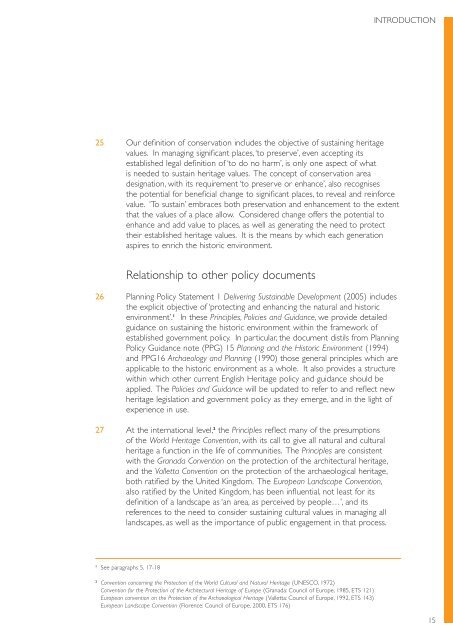Conservation Principles, Policies and Guidance - English Heritage
Conservation Principles, Policies and Guidance - English Heritage
Conservation Principles, Policies and Guidance - English Heritage
Create successful ePaper yourself
Turn your PDF publications into a flip-book with our unique Google optimized e-Paper software.
25 Our definition of conservation includes the objective of sustaining heritage<br />
values. In managing significant places, ‘to preserve’, even accepting its<br />
established legal definition of ‘to do no harm’, is only one aspect of what<br />
is needed to sustain heritage values. The concept of conservation area<br />
designation, with its requirement ‘to preserve or enhance’, also recognises<br />
the potential for beneficial change to significant places, to reveal <strong>and</strong> reinforce<br />
value. ‘To sustain’ embraces both preservation <strong>and</strong> enhancement to the extent<br />
that the values of a place allow. Considered change offers the potential to<br />
enhance <strong>and</strong> add value to places, as well as generating the need to protect<br />
their established heritage values. It is the means by which each generation<br />
aspires to enrich the historic environment.<br />
Relationship to other policy documents<br />
26 Planning Policy Statement 1 Delivering Sustainable Development (2005) includes<br />
the explicit objective of ‘protecting <strong>and</strong> enhancing the natural <strong>and</strong> historic<br />
environment’. 1 In these <strong>Principles</strong>, <strong>Policies</strong> <strong>and</strong> <strong>Guidance</strong>, we provide detailed<br />
guidance on sustaining the historic environment within the framework of<br />
established government policy. In particular, the document distils from Planning<br />
Policy <strong>Guidance</strong> note (PPG) 15 Planning <strong>and</strong> the Historic Environment (1994)<br />
<strong>and</strong> PPG16 Archaeology <strong>and</strong> Planning (1990) those general principles which are<br />
applicable to the historic environment as a whole. It also provides a structure<br />
within which other current <strong>English</strong> <strong>Heritage</strong> policy <strong>and</strong> guidance should be<br />
applied. The <strong>Policies</strong> <strong>and</strong> <strong>Guidance</strong> will be updated to refer to <strong>and</strong> reflect new<br />
heritage legislation <strong>and</strong> government policy as they emerge, <strong>and</strong> in the light of<br />
experience in use.<br />
27 At the international level, 2 the <strong>Principles</strong> reflect many of the presumptions<br />
of the World <strong>Heritage</strong> Convention, with its call to give all natural <strong>and</strong> cultural<br />
heritage a function in the life of communities. The <strong>Principles</strong> are consistent<br />
with the Granada Convention on the protection of the architectural heritage,<br />
<strong>and</strong> the Valletta Convention on the protection of the archaeological heritage,<br />
both ratified by the United Kingdom. The European L<strong>and</strong>scape Convention,<br />
also ratified by the United Kingdom, has been influential, not least for its<br />
definition of a l<strong>and</strong>scape as ‘an area, as perceived by people…’, <strong>and</strong> its<br />
references to the need to consider sustaining cultural values in managing all<br />
l<strong>and</strong>scapes, as well as the importance of public engagement in that process.<br />
1 See paragraphs 5, 17-18<br />
2 Convention concerning the Protection of the World Cultural <strong>and</strong> Natural <strong>Heritage</strong> (UNESCO, 1972)<br />
Convention for the Protection of the Architectural <strong>Heritage</strong> of Europe (Granada: Council of Europe, 1985, ETS 121)<br />
European convention on the Protection of the Archaeological <strong>Heritage</strong> (Valletta: Council of Europe, 1992, ETS 143)<br />
European L<strong>and</strong>scape Convention (Florence: Council of Europe, 2000, ETS 176)<br />
INTRODUCTION<br />
15

















